Voltage Estimation Method for Power Distribution Networks Using High-Precision Measurements
Abstract
1. Introduction
2. Existing Voltage Estimation Methods and Motivation of This Research
2.1. Voltage Measurement Methods and the Importance of Its Accuracy
2.2. Review of the Existing Studies on Voltage Estimation
2.2.1. Studies on SE Based on WLS
2.2.2. Studies on Voltage Estimation Based on Section Load Center
3. Proposed Voltage Estimation Method
3.1. Step 1: Identification of Section Types Using Measurement Data
3.2. Step 2: Calculation of Correction Parameter of the Section Load Center and Voltage Estimation
3.3. Step 3: Section Load and Loss Calculation
4. Case Study
4.1. Case 1: Simple Radial Distribution System with One DG
4.2. Case 2: Impact of Estimation Error Accumulation
4.3. Case 3: Radial Distribution System with Multiple DGs and Lateral Feeder
4.4. Case 4: Presence of Current Measurement Noise
4.5. Summary of Case Studies
- (1)
- Comparison of the voltage estimation accuracy of the FLC, IRWLS, and the proposed method through case study 1 indicates that a significant improvement in the estimation accuracy of the proposed method was observed when compared with the FLC method and a slight improvement accuracy was observed when compared with the IRWLS method. Comparison of the load estimation accuracy shows that the proposed method had a significant improvement in the estimation error when compared with the FLC and IRWLS methods. The FLC method and IRWLS method were significantly affected by PV, so the accuracy of load estimation was low, but the proposed method was verified so that it was less affected by PV and showed more accurate estimation results than other methods.
- (2)
- The proposed method performs sequential voltage estimation from the starting node to the end; therefore, the cumulative effect of the estimation error was analyzed in case study 2. In the FLC method, the estimation error of the previous node is accumulated as it is, and the estimation error of the next node increases. In the case of the proposed method, when the estimation error of the previous node occurs, the estimation error of the next node eventuates. However, it was confirmed that there was no accumulation of the effect toward the feeder end. These results indicate the robustness of the proposed method for the cumulative error propagation and its effectiveness for its application to the actual network.
- (3)
- When the HPM is installed only at the end of the main feeder, it was confirmed that the estimation error increased as the length of the lateral feeder increased. For some cases, an additional HPM may be required for the long-distance lateral feeder. In case study 3, it was confirmed that, when an additional HPM was installed at the lateral feeder, the estimated error was significantly improved compared to the case where an HPM was installed only at the end of the main feeder. This can be viewed as a significant reduction in the error for the network of this case study. If the actual network for application is determined, the number of installed HPMs can be examined through simulation as in the case study in this paper. The final number of installations will be determined by combining requirements such as the estimation accuracy and installation costs desired by the utility company.
- (4)
- When the measurement noises were injected into each estimation method in case study 4, the proposed method showed robustness to noise. The result of voltage estimation simulation with measurement noise was that the proposed method had higher accuracy than the FLC and IRWLS methods. Therefore, the proposed method can provide an improved estimation accuracy compared to the existing methods even with the presence of measurement noises. This is a significant advantage of applying the proposed method to the actual distribution system.
5. Conclusions
Author Contributions
Funding
Conflicts of Interest
References
- McDonald, J. Adaptive intelligent power systems: Active distribution networks. Energy Policy 2008, 36, 4346–4351. [Google Scholar] [CrossRef]
- Meliopoulos, A.P.S.; Polymeneas, E.; Tan, Z.; Huang, R.; Zhao, D. Advanced distribution management system. IEEE Trans. Smart Grid 2013, 4, 2109–2117. [Google Scholar] [CrossRef]
- American National Standard for Electric Power Systems and Equipment Voltage Ratings (60 Hertz); NEMA ANSI C84.1-2011; ANSI: Washington, DC, USA, 2011.
- Jin, T.H.; Chung, M.; Shin, K.Y.; Park, H.; Lim, G.P. Real-time dynamic simulation of korean power grid for frequency regulation control by MW battery energy storage system. J. Sustain. Dev. Energy Water Environ. Syst. 2016, 4, 392–407. [Google Scholar] [CrossRef]
- Virk, A.K. Maximum Loading of Radial Distribution Networks. Master’s Thesis, Electrical and Instrumentation Engineering Department, Thapar University, Patiala, India, 2009. [Google Scholar]
- IEC 61000-4-30: Testing and Measurement Techniques—Power Quality Measurement Methods; IEC: Geneva, Switzerland, 2012.
- Characteristic of Metering Out Fit. Available online: http://www.transformadores.cl/en/project/3-elements-metering-outfit/ (accessed on 9 September 2019).
- Micro-Synchrophasors for Distribution Grids. Available online: https://www.naspi.org/sites/default/files/2016-10/psl_mceachern_micro_synchrophasor_distribution_grid_20160323.pdf (accessed on 9 September 2019).
- Ju, Y.; Wu, W.; Ge, F.; Ma, K.; Lin, Y.; Ye, L. Fast decoupled state estimation for distribution networks considering branch ampere measurements. IEEE Trans. Smart Grid 2018, 9, 6338–6347. [Google Scholar] [CrossRef]
- Kong, X.; Chen, Y.; Xu, T.; Wang, C.; Yong, C.; Li, P.; Yu, A. hybrid state estimator based on SCADA and PMU measurements for medium voltage distribution system. Appl. Sci. 2018, 8, 1527. [Google Scholar] [CrossRef]
- Muscas, C.; Pau, M.; Pegoraro, P.A.; Sulis, S. Uncertainty of voltage profile in PMU-based distribution system state estimation. IEEE Trans. Instrum. Meas. 2016, 65, 988–998. [Google Scholar] [CrossRef]
- Muscas, C.; Sulis, S.; Angioni, A.; Ponci, F.; Monti, A. Impact of different uncertainty sources on a three-phase state estimator for distribution networks. IEEE Trans. Instrum. Meas. 2014, 63, 2200–2209. [Google Scholar] [CrossRef]
- Yun, S.-Y.; Chu, C.-M.; Kwon, S.-C.; Song, I.-K.; Choi, J.-H. The development and empirical evaluation of the korean smart distribution management system. Energies 2014, 7, 1332–1362. [Google Scholar] [CrossRef]
- Ali, A.-W.; Jianzhong, W.; Nick, J. State estimation of medium voltage distribution networks using smart meter measurements. Appl. Energy 2016, 184, 207–218. [Google Scholar]
- Park, J.-Y.; Jeon, C.-W.; Lim, S.-I. Accurate section loading estimation method based on voltage measurement error compensation in distribution systems. J. Korean Inst. Illum. Electr. Install. Eng. 2016, 30, 43–48. [Google Scholar]
- Park, S.-H.; Lim, S.-I. Voltage estimation method for distribution line with irregularly dispersed load. Trans. Korean Inst. Electr. Eng. 2018, 67, 491–497. [Google Scholar]
- Jin, S.L.; Gi, H.K. Comparison analysis of the voltage variation ranges for distribution networks. In Proceedings of the 2017 IEEE International Conference on Environment and Electrical Engineering and 2017 IEEE Industrial and Commercial Power Systems Europe (EEEIC/I & CPS Europe), Milan, Italy, 6–9 June 2017; pp. 1–3. [Google Scholar]
- Korea Consumer’s Electrical Installation Guide; Korea Electric Association: Seoul, Korea, 2013.
- CSA. C22.3 NO.1-15; CSA: Toronto, ON, Canada, 2015; pp. 29–51. [Google Scholar]
- NFPA 70, National Electrical Code, 2005th ed.; NFPA: Quincy, MA, USA, 2005.
- Jackson, J. Future Energy, 2nd ed.; Elsevier: Amsterdam, The Netherlands, 2014; pp. 633–651. [Google Scholar]
- AMDS of ABB. Available online: https://library.e.abb.com/public/002f1838275e45caabba43ba03d07a2e/ADMS_9AKK106930A8216-A4-web.pdf (accessed on 20 October 2019).
- ADMS of, GE. Available online:. Available online: https://www.ge.com/digital/sites/default/files/download_assets/brochure_reliability%20response_PowerOnAdvantage-web.V1.pdf (accessed on 20 October 2019).
- Active Network Management of Siemens. Available online: https://pdfs.semanticscholar.org/a2e3/44fedf33d1009a11c643ff84b537b289ebee.pdf (accessed on 20 October 2019).
- Gonen, T. Electric Power Distribution System Engineering, 2nd ed.; CRC Press: Boca Raton, FL, USA, 2008. [Google Scholar]
- Choi, J.-H.; Park, D.-H. Mid-To-Long Term Operation Plan of Distribution Control Center According to Expansion of Distribution System Intelligent Equipment (Final Report); KEPCO: Naju, Korea, 2017; pp. 14–38. [Google Scholar]
- Panda Power. Available online: http://www.pandapower.org/ (accessed on 6 April 2020).
- Commercial and Residential Hourly Load Profiles for all TMY3 Locations in the United States. Open EI. Available online: https://openei.org/doe-opendata/dataset/commercial-and-residential-hourly-load-profiles-for-all-tmy3-locations-in-the-united-states (accessed on 5 April 2020).
- IEC 61869-2, Instrument Transformers—Part 2: Additional Requirements for Current Transformers; IEC: Geneva, Switzerland, September 2012.
- IEC 62053-11, Electricity Metering Equipment (a.c.)—Particular Requirements—Part 11: Electromechanical Meters for Active Energy (classes 0, 5, 1 and 2); IEC: Geneva, Switzerland, 2003.
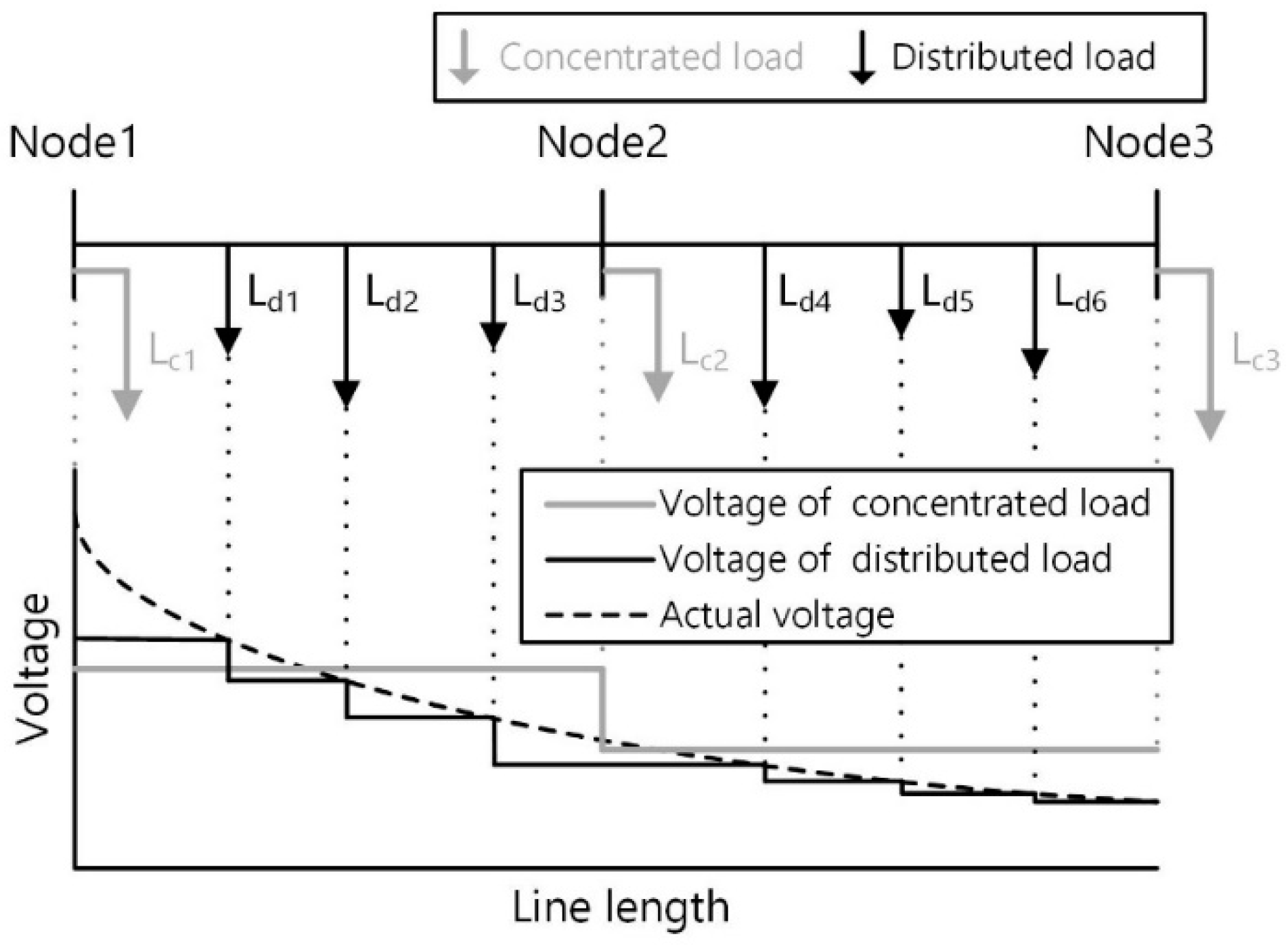
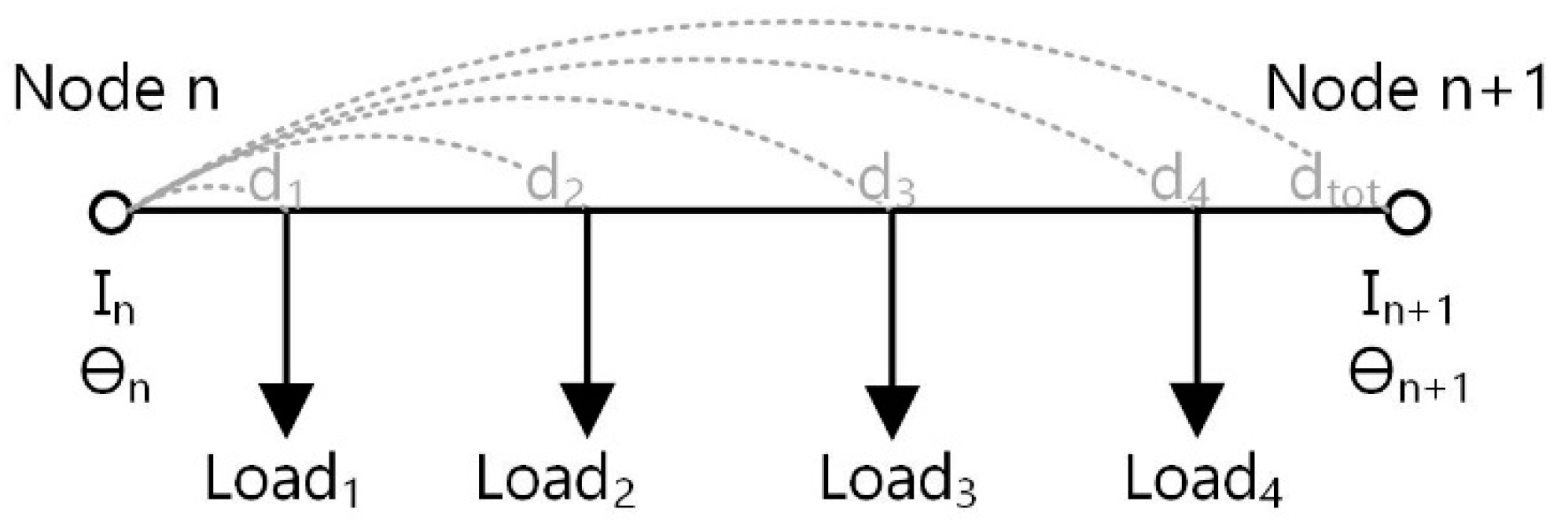










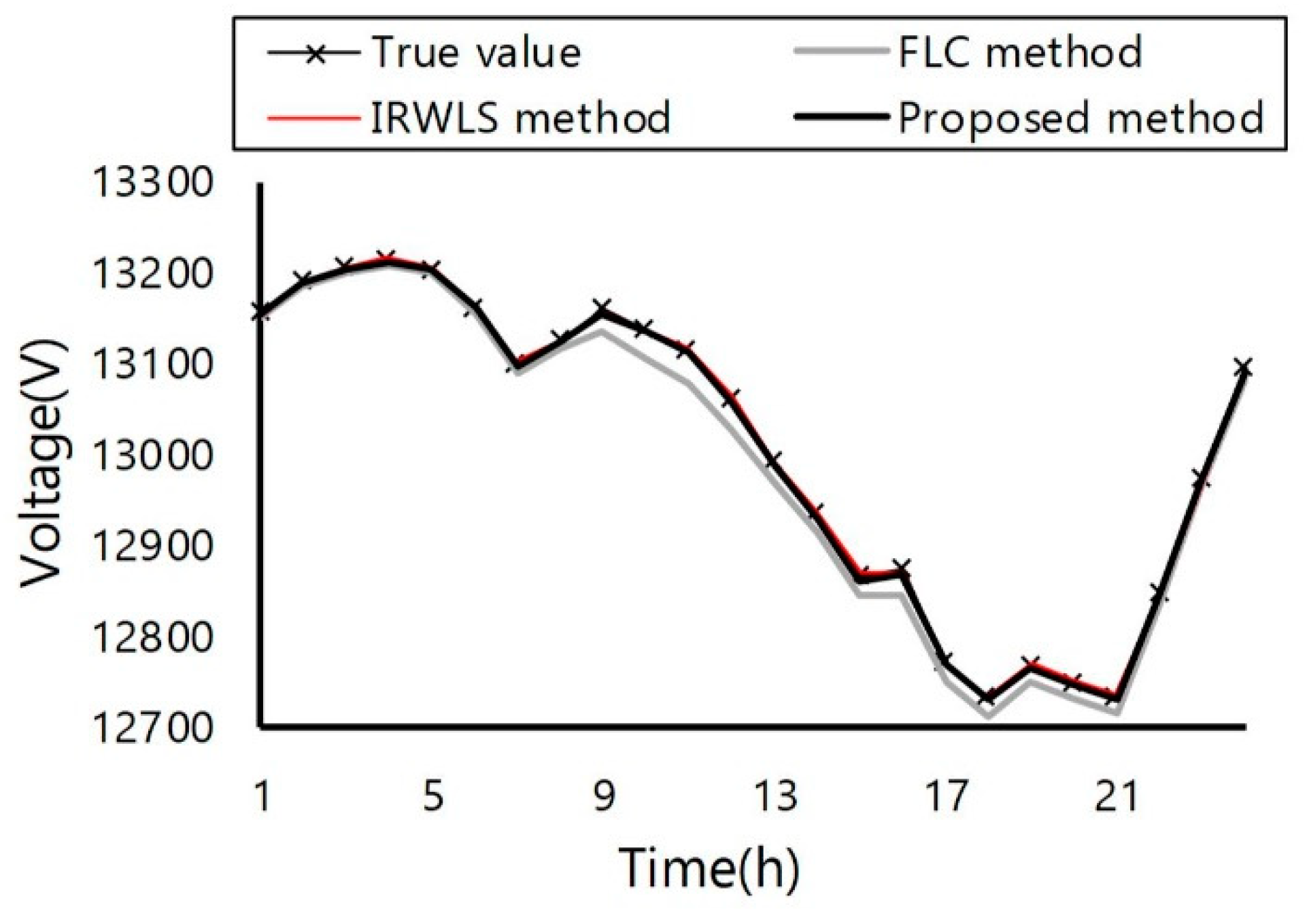
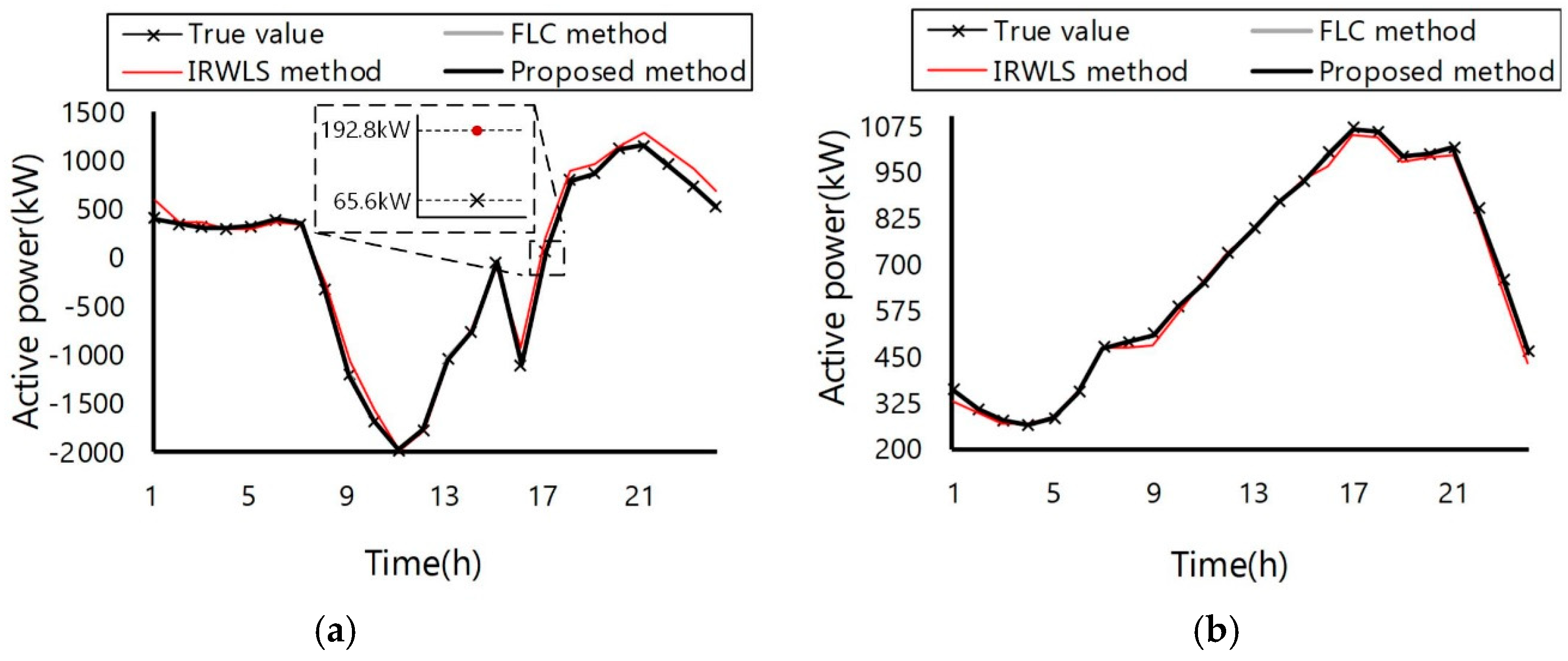

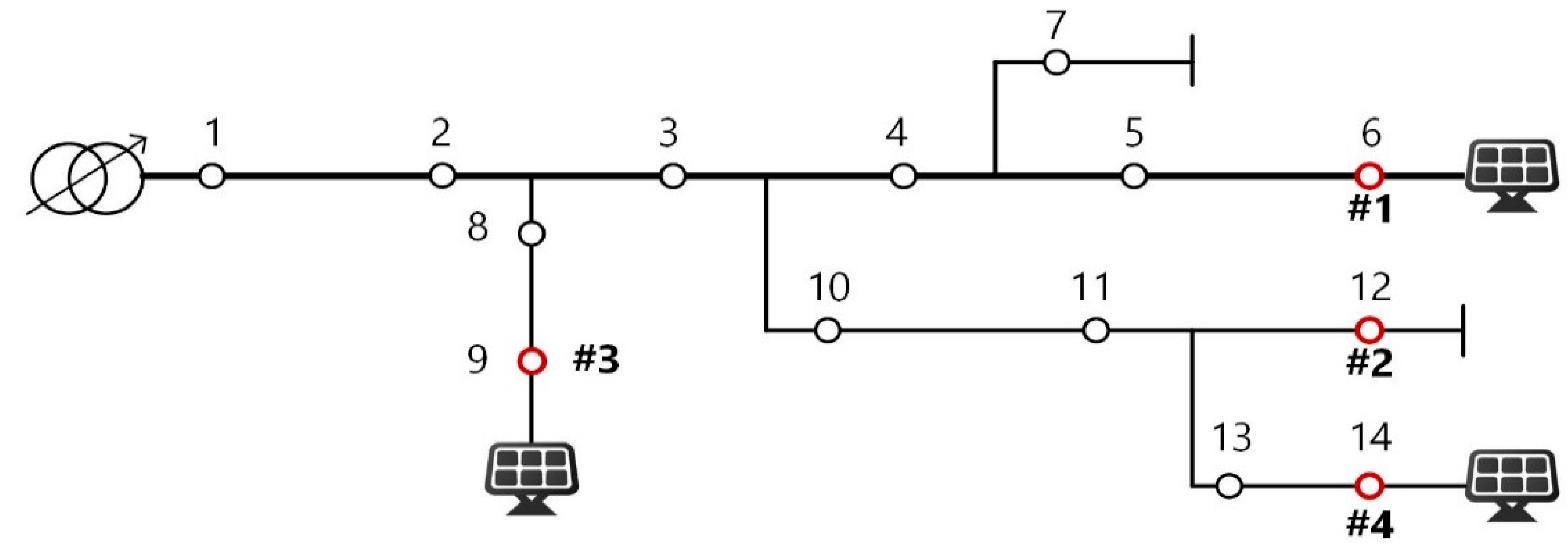
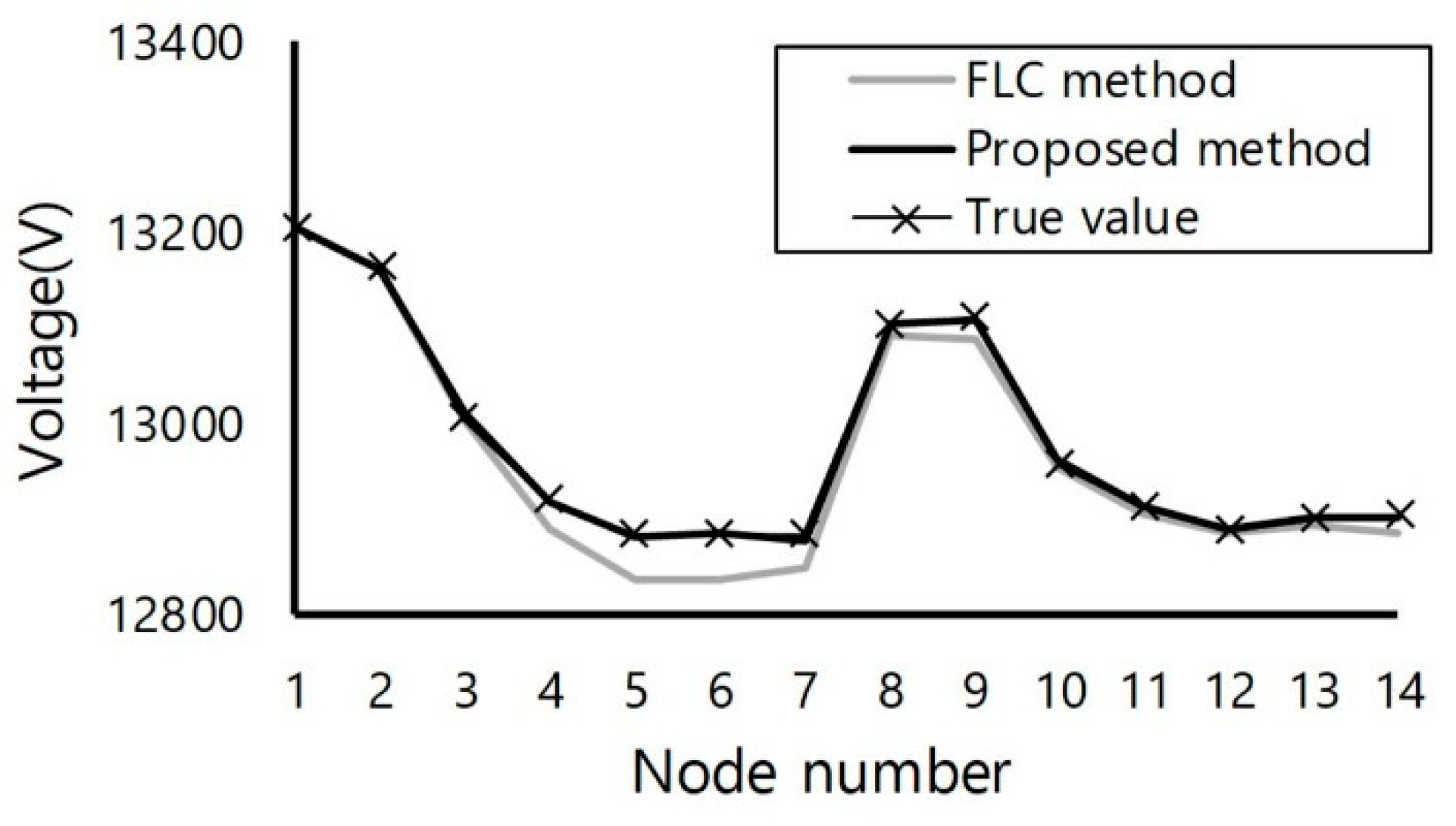
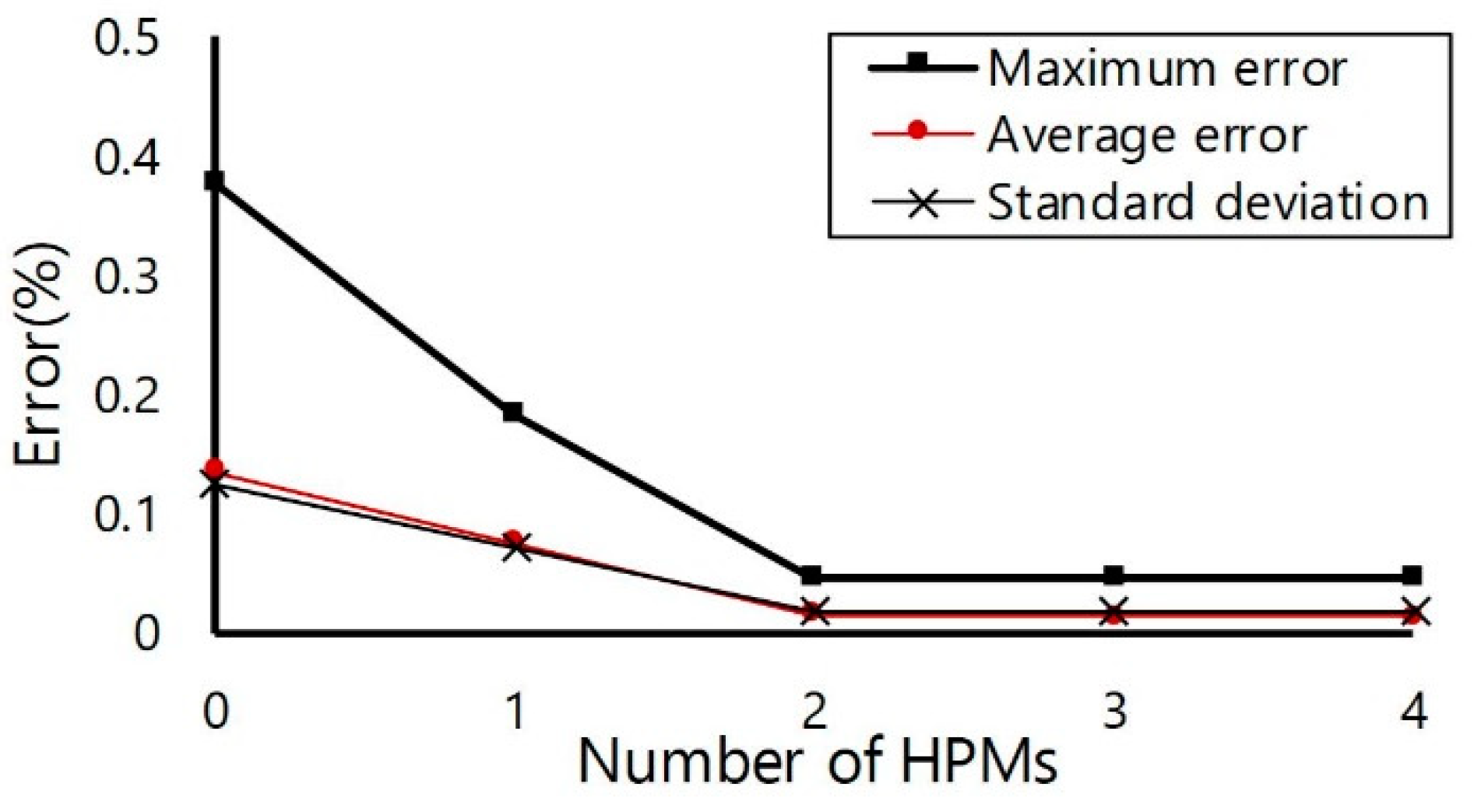

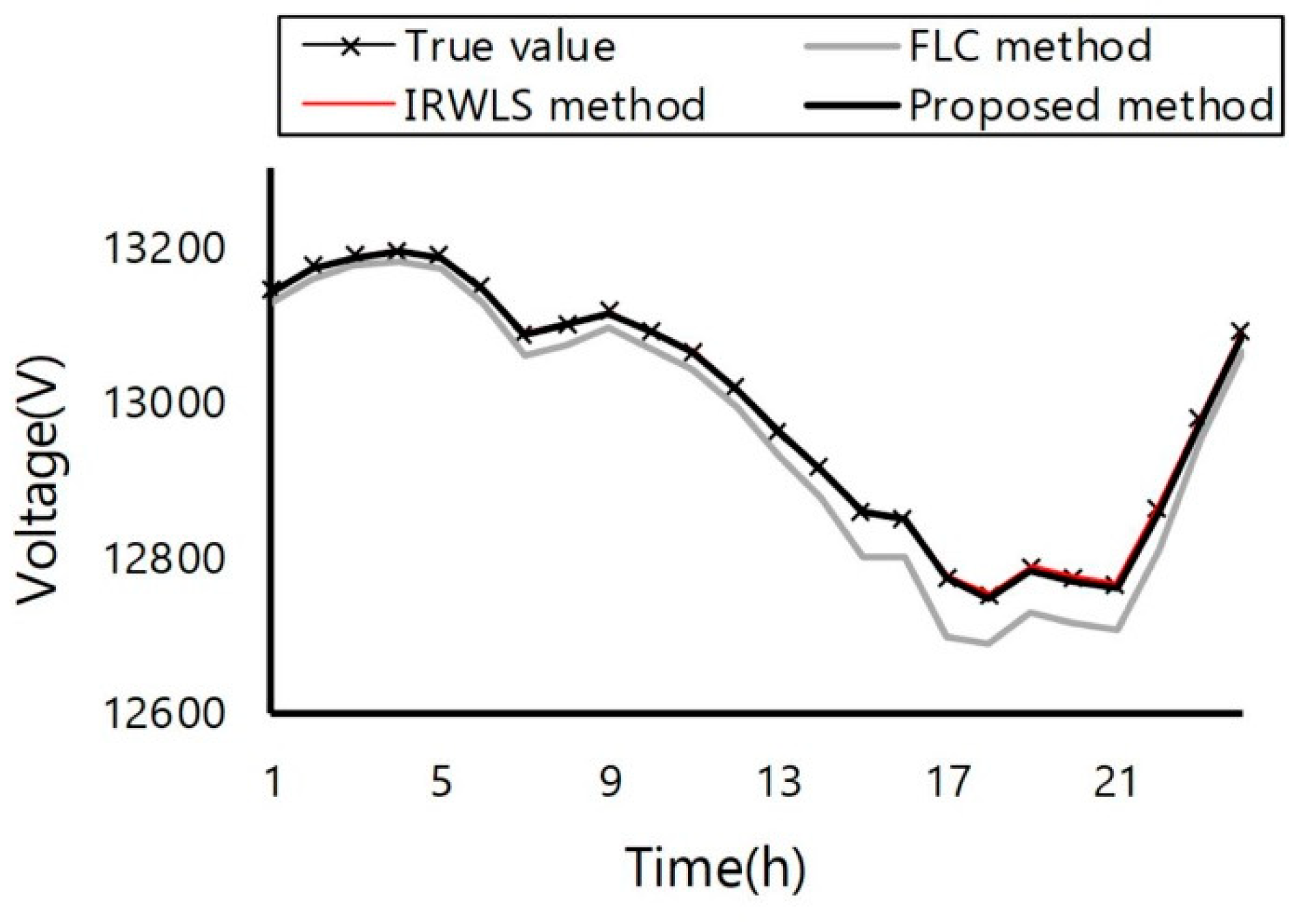
| Country | Nominal Voltage (V) | Variation Range (min./max. limit) | Standard | Maximum Voltage Drop | |
|---|---|---|---|---|---|
| Primary (High Volt) | Secondary (Low Volt) | ||||
| Australia | 230 | −6.1/+10.0% | ANSI C84.1 [3] | 0.03 pu | 0.05 pu |
| Canada | 120 | −8.3/+4.2% | |||
| Germany | 230 | 10.0% | CEIG (Korea) [18] | 0.02 pu | 0.04 pu |
| Japan | 100 | 6.0% | |||
| Korea | 220 | 5.9% | CSA C22.1-15 [19] | 0.03 pu | 0.05 pu |
| U.K. | 230 | −6.0/+10.0% | |||
| U.S. | 120 | 5.0% | NFPA 70 [20] | 0.03 pu | 0.05 pu |
| Section No. | From Node | To Node | Line | Section Load | Initial Load Center | |||
|---|---|---|---|---|---|---|---|---|
| No. | Length (km) | No. | Active Power (kW) | Reactive Power (kVar) | ||||
| 1 | 1 | 2 | 1 | 1.177 | 1 2 3 | 956.3 141.8 476.8 | 463.1 68.7 230.9 | 0.631 |
| 2 | 0.459 | |||||||
| 3 | 1.351 | |||||||
| 4 | 1.013 | |||||||
| 2 | 2 | 3 | 1 | 1.154 | 1 2 3 | 778.0 770.1 729.2 | 376.8 373.0 353.1 | 0.735 |
| 2 | 1.410 | |||||||
| 3 | 0.356 | |||||||
| 4 | 1.08 | |||||||
| 3 | 3 | 4 | 1 | 1.381 | 1 | 228.3 | 110.5 | 0.795 |
| 2 | 0.772 | 2 | 817.7 | 396.0 | ||||
| 3 | 1.233 | 3 | −29,709.2 | 140.8 | ||||
| 4 | 0.614 | (PV) | ||||||
| 4 | 4 | 5 | 1 | 1.684 | 1 2 3 | 356.4 219.1 628.6 | 172.6 106.1 304.4 | 0.951 |
| 2 | 0.775 | |||||||
| 3 | 1.162 | |||||||
| 4 | 0.379 | |||||||
| 5 | 5 | 6 | 1 | 0.589 | 1 2 3 | 701.9 756.9 147.5 | 339.9 366.6 71.4 | 0.431 |
| 2 | 1.053 | |||||||
| 3 | 0.784 | |||||||
| 4 | 1.574 | |||||||
| Method | Voltage Estimation Error | Load Estimation Error | ||||
|---|---|---|---|---|---|---|
| Average (%) | Maximum (%) | Standard Deviation | Average (%) | Maximum (%) | Standard Deviation | |
| FLC Method | 0.1037 | 0.3228 | 0.0801 | 0.1800 | 1.6618 | 0.2303 |
| IRWLS Method | 0.0153 | 0.0464 | 0.0101 | 6.1981 | 193.85 | 19.781 |
| Proposed Method | 0.0088 | 0.0457 | 0.0096 | 0.1258 | 1.1968 | 0.2308 |
| Section No. | From Node | To Node | Line | Section Load | Initial Load Center | Changed Load Center | |||
|---|---|---|---|---|---|---|---|---|---|
| No. | Length (km) | No. | Active Power (kW) | Reactive Power (kVar) | |||||
| 1 | 1 | 2 | 1 | 0.123 | 1 2 3 | 66.7 109.0 37.3 | 25.1 51.0 13.6 | 0.368 | 0.152 |
| 2 | 0.323 | ||||||||
| 3 | 0.240 | ||||||||
| 4 | 0.114 | ||||||||
| 2 | 2 | 3 | 1 | 0.715 | 1 2 3 | 344.7 453.0 247.2 | 140.1 217.2 95.0 | 0.616 | 0.401 |
| 2 | 0.790 | ||||||||
| 3 | 0.944 | ||||||||
| 4 | 0.751 | ||||||||
| 3 | 3 | 4 | 1 | 1.122 | 1 2 3 | 37.9 858.5 590.9 | 15.0 253.6 227.7 | 0.727 | 0.511 |
| 2 | 1.035 | ||||||||
| 3 | 0.382 | ||||||||
| 4 | 0.660 | ||||||||
| 4 | 4 | 5 | 1 | 0.84 | 1 2 3 | 394.7 878.1 4.7 | 160.4 383.4 2.1 | 0.956 | 0.740 |
| 2 | 1.124 | ||||||||
| 3 | 0.598 | ||||||||
| 4 | 0.638 | ||||||||
| 5 | 5 | 6 | 1 | 0.280 | 1 | 117.4 | 49.8 | - | - |
| 2 | 0.774 | 2 | 372.0 | 147.4 | |||||
| 3 | 0.244 | 3 | 24.2 | 11.60 | |||||
| 4 | 0.301 | 4 | −1000.0 (PV) | 0 | |||||
| 6 | 7 | - | 1 | 0.237 | 1 | 71.1 | 23.4 | 0.450 | 0.235 |
| 2 | 0.110 | 2 | 196.6 | 94.6 | |||||
| 3 | 0.608 | 3 | 620.6 | 290.0 | |||||
| 7 | 8 | 9 | 1 | 0.255 | 1 | 173.0 | 59.1 | 0.342 | 0.127 |
| 2 | 0.810 | 2 | 416.8 | 142.2 | |||||
| 3 | 0.611 | 3 | 315.9 | 135.9 | |||||
| 4 | 0.725 | 4 | −1000.0 (PV) | 0 | |||||
| 8 | 10 | 11 | 1 | 0.979 | 1 2 3 | 247.9 411.6 82.5 | 86.7 178.3 27.1 | 0.549 | 0.333 |
| 2 | 0.918 | ||||||||
| 3 | 0.139 | ||||||||
| 4 | 0.363 | ||||||||
| 9 | 11 | 12 | 1 | 1.333 | 1 2 3 | 220.5 115.4 578.0 | 103.1 54.0 242.9 | 0.314 | 0.098 |
| 2 | 0.821 | ||||||||
| 3 | 0.527 | ||||||||
| 4 | 0.519 | ||||||||
| 10 | 12 | - | 1 | 0.087 | 1 | 60.3 | 23.8 | - | - |
| 2 | 0.248 | 2 | 63.7 | 23.5 | |||||
| 3 | 0.235 | 3 | 197.5 | 83.3 | |||||
| 11 | 13 | 14 | 1 | 0.131 | 1 | 164.3 | 56.6 | 0.516 | 0.301 |
| 2 | 0.905 | 2 | 95.0 | 40.5 | |||||
| 3 | 0.727 | 3 | 818.2 | 277.1 | |||||
| 4 | 0.637 | 4 | −1000.0 (PV) | 0 | |||||
| Method | Noise | Voltage Estimation Error | ||
|---|---|---|---|---|
| Average (%) | Maximum (%) | Standard Deviation | ||
| IRWLS Method | ±0% | 0.0236 | 0.1266 | 0.0231 |
| ±1% | 0.0237 | 0.1263 | 0.0231 | |
| ±2% | 0.0235 | 0.1268 | 0.0230 | |
| FLC Method | ±0% | 0.0857 | 0.5377 | 0.1219 |
| ±1% | 0.0882 | 0.5194 | 0.1250 | |
| ±2% | 0.0903 | 0.5406 | 0.1251 | |
| ±3% | 0.0889 | 0.5285 | 0.1236 | |
| ±4% | 0.0905 | 0.5824 | 0.1266 | |
| ±5% | 0.0957 | 0.6210 | 0.1304 | |
| Proposed Method | ±0% | 0.0222 | 0.0853 | 0.0089 |
| ±1% | 0.0229 | 0.0857 | 0.0089 | |
| ±2% | 0.0228 | 0.0830 | 0.0090 | |
| ±3% | 0.0226 | 0.0942 | 0.0085 | |
| ±4% | 0.0231 | 0.0976 | 0.0093 | |
| ±5% | 0.0234 | 0.0982 | 0.0094 | |
© 2020 by the authors. Licensee MDPI, Basel, Switzerland. This article is an open access article distributed under the terms and conditions of the Creative Commons Attribution (CC BY) license (http://creativecommons.org/licenses/by/4.0/).
Share and Cite
Oh, C.-H.; Go, S.-I.; Choi, J.-H.; Ahn, S.-J.; Yun, S.-Y. Voltage Estimation Method for Power Distribution Networks Using High-Precision Measurements. Energies 2020, 13, 2385. https://doi.org/10.3390/en13092385
Oh C-H, Go S-I, Choi J-H, Ahn S-J, Yun S-Y. Voltage Estimation Method for Power Distribution Networks Using High-Precision Measurements. Energies. 2020; 13(9):2385. https://doi.org/10.3390/en13092385
Chicago/Turabian StyleOh, Chan-Hyeok, Seok-Il Go, Joon-Ho Choi, Seon-Ju Ahn, and Sang-Yun Yun. 2020. "Voltage Estimation Method for Power Distribution Networks Using High-Precision Measurements" Energies 13, no. 9: 2385. https://doi.org/10.3390/en13092385
APA StyleOh, C.-H., Go, S.-I., Choi, J.-H., Ahn, S.-J., & Yun, S.-Y. (2020). Voltage Estimation Method for Power Distribution Networks Using High-Precision Measurements. Energies, 13(9), 2385. https://doi.org/10.3390/en13092385







